Optimal Design of a Novel Hybrid Electric Powertrain for Tracked Vehicles
Abstract
:1. Introduction
- (1)
- A novel hybrid electric powertrain with two outputs using three PGs is proposed for tracked vehicles. The novel powertrain outperforms current powertrains, which can be promising for future industrial application.
- (2)
- A rapid screening method for hybrid power-split topologies using three PGs has been proposed. The method will help engineers identify superior topologies much more quickly among a great number of candidates. An integrated optimization problem has been solved taking into account the topology, size and control. The method is able to identify an economical optimal design with downsized components. The design procedure can be applied to various vehicle powertrain designs.
2. The Novel Multi-Mode Hybrid Electric Powertrain
3. Rapid Modeling and Screening for 3PG Powertrain Design
3.1. Initial Screening of Configurations and Designs
- Three connections from one node of a PG to all three nodes of another PG are not allowed.
- Three nodes of a PG are all grounded.
- Two nodes of one PG are connected while the third is grounded.
- Two nodes of a PG are grounded while the left node of this PG is used in another connection.
- Any node of a PG is free without any connection.
3.2. Rapid Automated Modeling for Multi-Mode Designs
3.3. Attribute Screening
3.4. Performance Screening
4. Energy Management Strategy for Rapid Sizing: E-PEARS+
5. Integrated Optimization of Multi-Mode Hybrid Electric TTDS
6. Conclusions
Acknowledgments
Author Contributions
Conflicts of Interest
Nomenclature
| A* | characteristic matrix |
| c | constraint number |
| C* | cost of components |
| unit price of per gallon | |
| Fstraight | fuel consumption during straight driving |
| Fturn | fuel consumption during turning |
| F* | internal force of PGs acting between gears |
| FR | final drive of the right track |
| FL | final drive of the left track |
| GR | gear ratio of PGs |
| I* | inertia of the components |
| m | vehicle mass |
| n | planetary gear number |
| P* | power of the components |
| r* | radius of the ring gear |
| S* | scaling factor of components |
| s* | radius of the sun gear |
| T* | torque of the components |
| Vl | speed of the left track |
| Vr | speed of the right track |
| V | central speed |
| convergence parameter | |
| attraction parameter | |
| angular acceleration of the components | |
| operating efficiency of the components | |
| Acronyms | |
| DOF | Degree of Freedom |
| DP | Dynamic Programming |
| GA | Genetic Algorithm |
| MPC | Model Predictive Control |
| NSGA | Non-dominated Sorting Genetic Algorithm |
| PG | Planetary Gear |
| PSO | Particle Swarm Optimization |
| SOC | State of Charge |
| TTD | Track-type Dozer |
| ECMS | Equivalent Consumption Minimization Strategy |
| PEARS | Power-weighted Efficiency Analysis for Rapid Sizing |
References
- Wang, H.; Liu, L.; Zheng, G. Study of Two-Motor Hybrid Bulldozer; SAE Technical Paper; SAE International: Warrendale, PA, USA, 2014. [Google Scholar]
- Gordon, T.D.; Tkacik, D.S.; Presto, A.A.; Zhang, M.; Jathar, S.H.; Nguyen, N.T.; Massetti, J.; Truong, T.; Cicero-Fernandez, P.; Maddox, C.; et al. Primary gas-and particle-phase emissions and secondary organic aerosol production from gasoline and diesel off-road engines. Environ. Sci. Technol. 2013, 47, 14137–14146. [Google Scholar] [CrossRef] [PubMed]
- Sangshin, K.; Kim, T.; Park, G. Phase-redundant-based reliable direct AC/AC converter drive for series hybrid off-highway heavy electric vehicles. IEEE Trans. Veh. Technol. 2010, 59, 2674–2688. [Google Scholar] [CrossRef]
- Wang, J.; Yang, Z.; Liu, S.; Zhang, Q.; Han, Y. A comprehensive overview of hybrid construction machinery. Adv. Mech. Eng. 2016, 8. [Google Scholar] [CrossRef]
- Mehrdad, E.; Gao, Y.; Gay, S. Characterization of electric motor drives for traction applications. In Proceedings of the 29th Annual Conference of the IEEE Industrial Electronics Society, Roanoke, VA, USA, 2–6 November 2003; IEEE: Piscataway, NJ, USA, 2003; Volume 1. [Google Scholar]
- Wang, H.; Huang, Y.; Khajepour, A.; Song, Q. Model predictive control-based energy management strategy for a series hybrid electric tracked vehicle. Appl. Energy 2016, 182, 105–114. [Google Scholar] [CrossRef]
- Wang, H.; Huang, Y.; Lv, C.; Khajepour, A. A Global Optimal Energy Management System for Hybrid Electric off-road Vehicles. SAE Int. J. Commer. Veh. 2017, 10, 524–531. [Google Scholar]
- Liu, T.; Zou, Y.; Liu, D.; Sun, F. Reinforcement learning of adaptive energy management with transition probability for a hybrid electric tracked vehicle. IEEE Trans. Ind. Electron. 2015, 62, 7837–7846. [Google Scholar] [CrossRef]
- Schmidt, M.R. Two-Mode, Compound-Split, Electro-Mechanical, Vehicular Transmission Particulary Adapted for Track-Laying Vehicles. U.S. Patent 6,491,599, 10 December 2002. [Google Scholar]
- Shabana, A.A. Nonlinear Dynamics of Tracked Vehicles; Chicago University: Chicago, IL, USA, 1997. [Google Scholar]
- Han, Z.; Mao, M.; Ma, X.; Gai, J. Research no mathematical characteristics of coupling mechanism for electro-mechanical transmission tracked vehicle. Veh. Power Technol. 2012, 125, 1–2. [Google Scholar]
- Tanoue, K.; Yanagihara, H.; Kusumi, H. Hybrid is a Key Technology for Future Automobiles. In Hydrogen Technology; Springer: Berlin, Germany, 2008; ISBN 978-3-540-79027-3. [Google Scholar]
- Matthé, R.; Eberle, U. The Voltec System-Energy Storage and Electric Propulsion. In Lithium-Ion Batteries: Advances and Applications; Elsevier: Amsterdam, The Netherlands, 2014; pp. 151–176. ISBN 9780444595133. [Google Scholar]
- Zhuang, W.; Zhang, X.; Peng, H.; Wang, L. Simultaneous Optimization of Topology and Component Sizes for Double Planetary Gear Hybrid Powertrains. Energies 2016, 9, 411. [Google Scholar]
- Yoshimura, T. Vehicle Power Transmission. U.S. Patent 8,535,189 B2, 17 September 2013. [Google Scholar]
- Silvas, E.; Hofman, T.; Murgovski, N. Review of optimization strategies for system-level design in hybrid electric vehicles. IEEE Trans. Veh. Technol. 2017, 66, 57–70. [Google Scholar] [CrossRef]
- Liu, J.; Peng, H. Modeling and control of a power-split hybrid vehicle. IEEE Trans. Control Syst. Technol. 2008, 16, 1242–1251. [Google Scholar]
- Zhang, X.; Li, S.E.; Peng, H. Efficient exhaustive search of power-split hybrid powertrains with multiple planetary gears and clutches. J. Dyn. Syst. Meas. Control 2015, 137, 121006. [Google Scholar] [CrossRef]
- Wang, X.; He, H.; Sun, F.; Tang, H. Comparative study on different energy management strategies for plug-in hybrid electric vehicles. Energies 2013, 6, 5656–5675. [Google Scholar] [CrossRef]
- Johannesson, L.; Asbogard, M.; Egardt, B. Assessing the potential of predictive control for hybrid vehicle powertrains using stochastic dynamic programming. IEEE Trans. Intell. Transp. Syst. 2007, 8, 71–83. [Google Scholar] [CrossRef]
- Musardo, C.; Rizzoni, G.; Guezennec, Y. A-ECMS: An adaptive algorithm for hybrid electric vehicle energy management. Eur. J. Control 2005, 11, 509–524. [Google Scholar] [CrossRef]
- Fang, L.C.; Qin, S.Y.; Xu, G.; Li, T.L.; Zhu, K.M. Simultaneous optimization for hybrid electric vehicle parameters based on multi-objective genetic algorithms. Energies 2011, 4, 532–544. [Google Scholar] [CrossRef]
- Ebbesen, S.; Doenitz, C.; Guzzella, L. Particle swarm optimisation for hybrid electric drive-train sizing. Int. J. Veh. Des. 2012, 58, 181–199. [Google Scholar] [CrossRef]
- Wu, L.H.; Wang, Y.N.; Yuan, X.F.; Chen, Z.L. Multiobjective optimization of HEV fuel economy and emissions using the self-adaptive differential evolution algorithm. IEEE Trans. Veh. Technol. 2011, 60, 2458–2470. [Google Scholar] [CrossRef]
- Castaings, A.; Lhomme, W.; Trigui, R.; Bouscayrol, A. Comparison of energy management strategies of a battery/supercapacitors system for electric vehicleunder real-time constraints. Appl. Energy 2016, 163, 190–200. [Google Scholar] [CrossRef]
- Zhang, L.; Hu, X.; Wang, Z.; Sun, F.; Deng, J.; Dorrell, D. Multi-Objective Optimal Sizing of Hybrid Energy Storage System for Electric Vehicles. IEEE Trans. Veh. Technol. 2017. [Google Scholar] [CrossRef]
- Rahman, I.; Vasant, P.M.; Singh, B.S.M.; Abdullah-Al-Wadud, M. On the performance of accelerated particle swarm optimization for charging plug-in hybrid electric vehicles. Alex. Eng. J. 2016, 55, 419–426. [Google Scholar] [CrossRef]
- Luo, Y.-Z.; Tang, G.-J.; Zhou, L.-N. Hybrid approach for solving systems of nonlinear equations using chaos optimization and quasi-Newton method. Appl. Soft Comput. 2008, 8, 1068–1073. [Google Scholar] [CrossRef]
- Zhou, Q.; Zhang, W.; Cash, S.; Olatunbosun, O.; Xu, H.; Lu, G. Intelligent sizing of a series hybrid electric power-train system based on Chaos-enhanced accelerated particle swarm optimization. Appl. Energy 2017, 189, 588–601. [Google Scholar] [CrossRef]
- Liu, J. Modeling, Configuration and Control Optimization of Power-Split Hybrid Vehicles; The University of Michigan: Ann Arbor, MI, USA, 2007. [Google Scholar]
- Hong, S.; Choi, W.; Ahn, S. Mode shift control for a dual-mode power-split-type hybrid electric vehicle. Proc. Inst. Mech. Eng. Part D J. Automob. Eng. 2014, 228, 1217–1231. [Google Scholar] [CrossRef]
- Sergeyev, Y.D.; Grishagin, V.A. Parallel asynchronous global search and the nested optimization scheme. J. Comput. Anal. Appl. 2010, 3, 123–145. [Google Scholar]
- Golbuff, S. Optimization of a Plug-in Hybrid Electric Vehicle. Master’s Thesis, Georgia Institute of Technology, Atlanta, GA, USA.
- Graham, R. Comparing the Benefits and Impacts of Hybrid Electric Vehicle Options; Electric Power Research Institute (EPRI): Palo Alto, CA, USA, 2001. [Google Scholar]
- Hu, X.; Murgovski, N.; Johannesson, L.M. Comparison of three electrochemical energy buffers applied to a hybrid bus powertrain with simultaneous optimal sizing and energy management. IEEE Trans. Intell. Transp. Syst. 2014, 15, 1193–1205. [Google Scholar] [CrossRef]
- Benford, H.; Leising, M. The Lever Analogy: A New Tool in Transmission Analysis; SAE Paper 810102; SAE International: Warrendale, PA, USA, 1981. [Google Scholar]
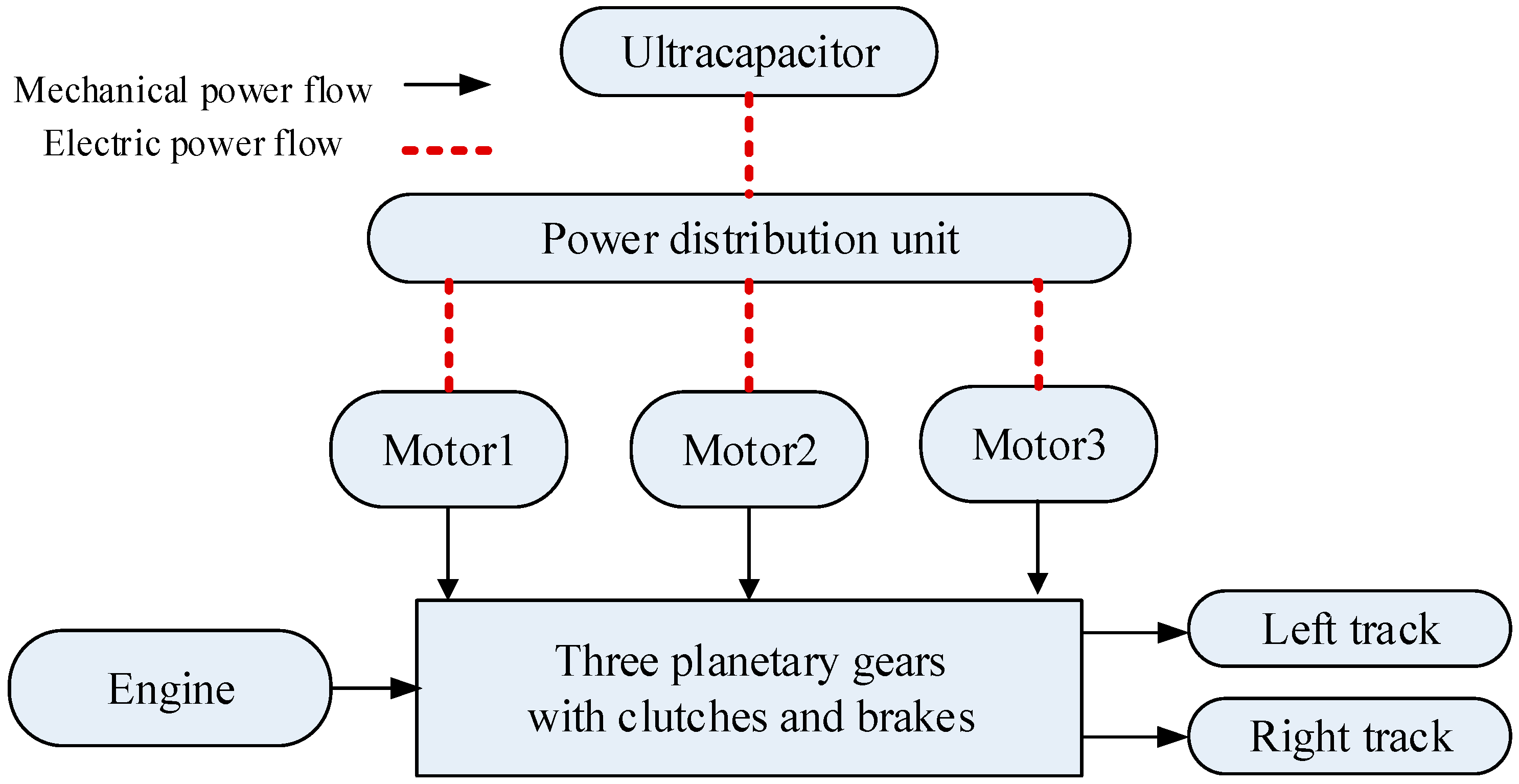
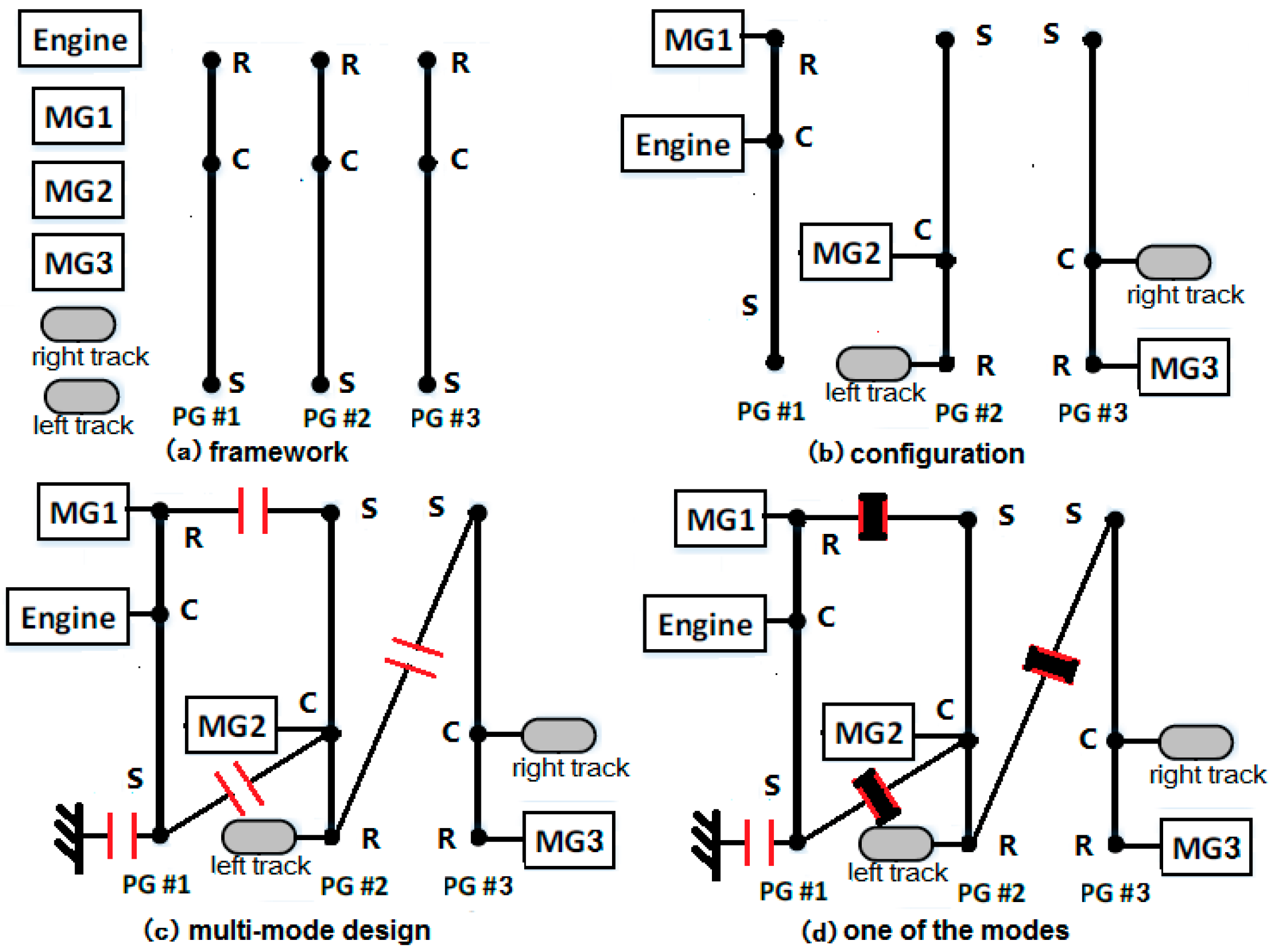

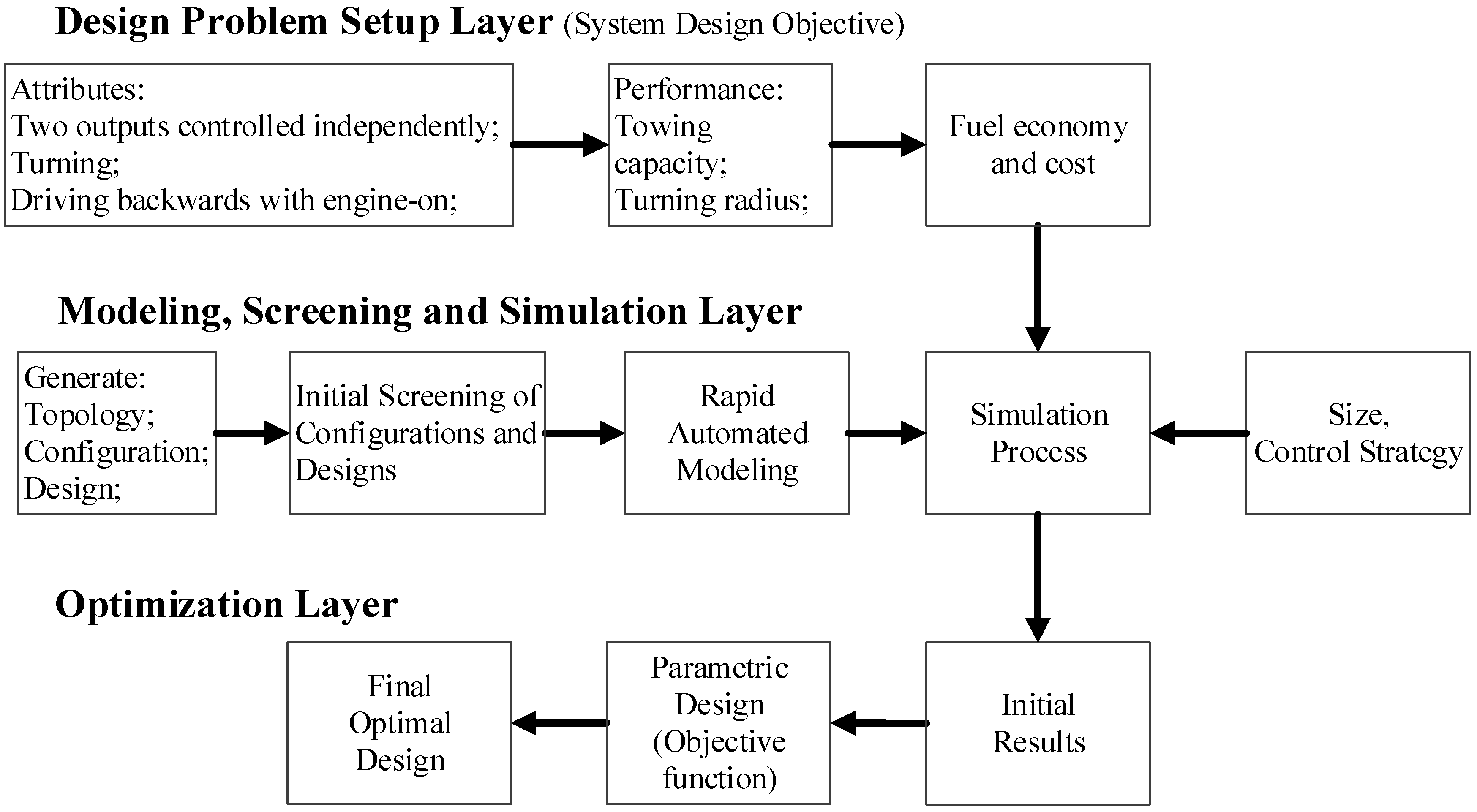
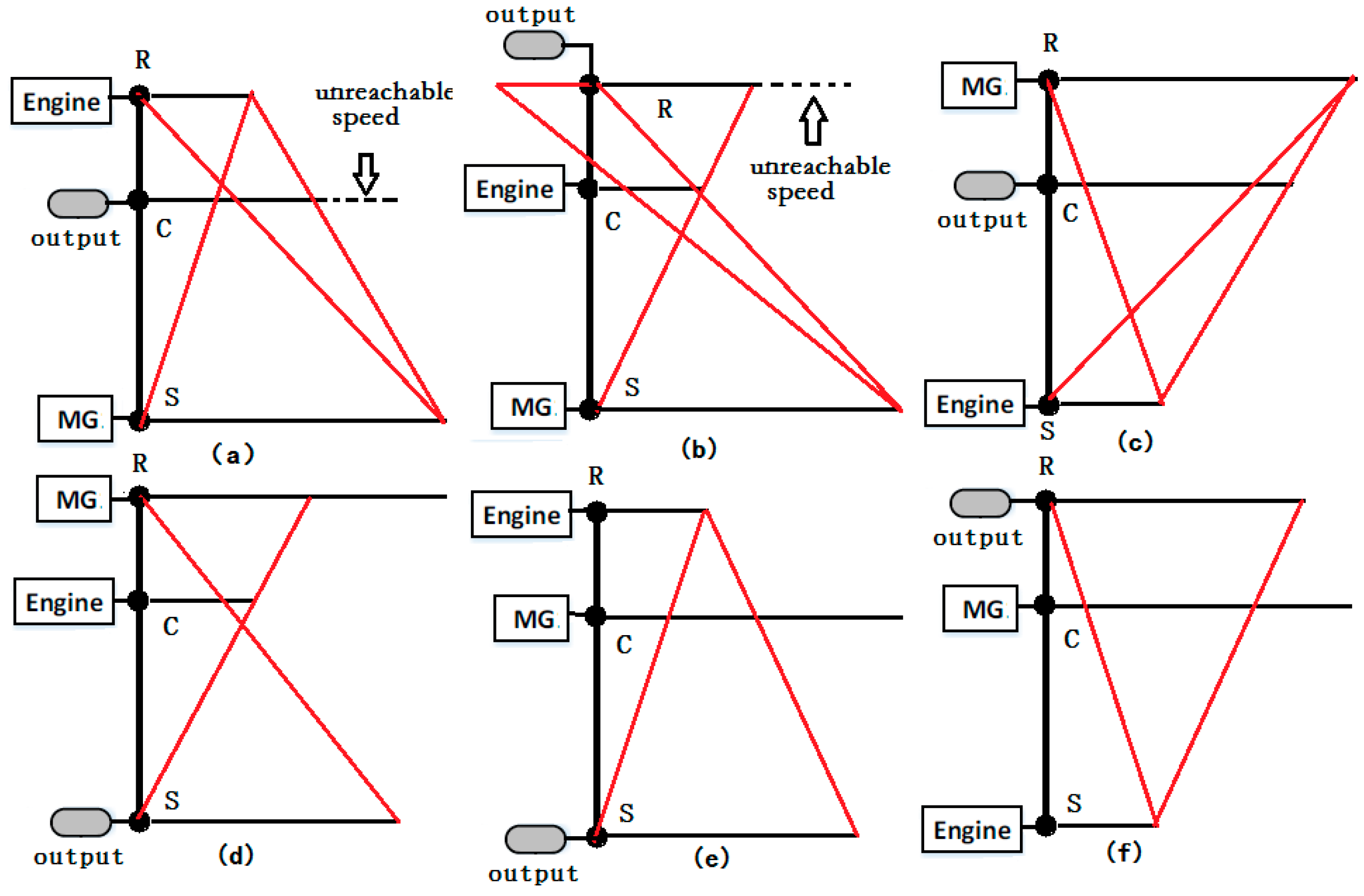
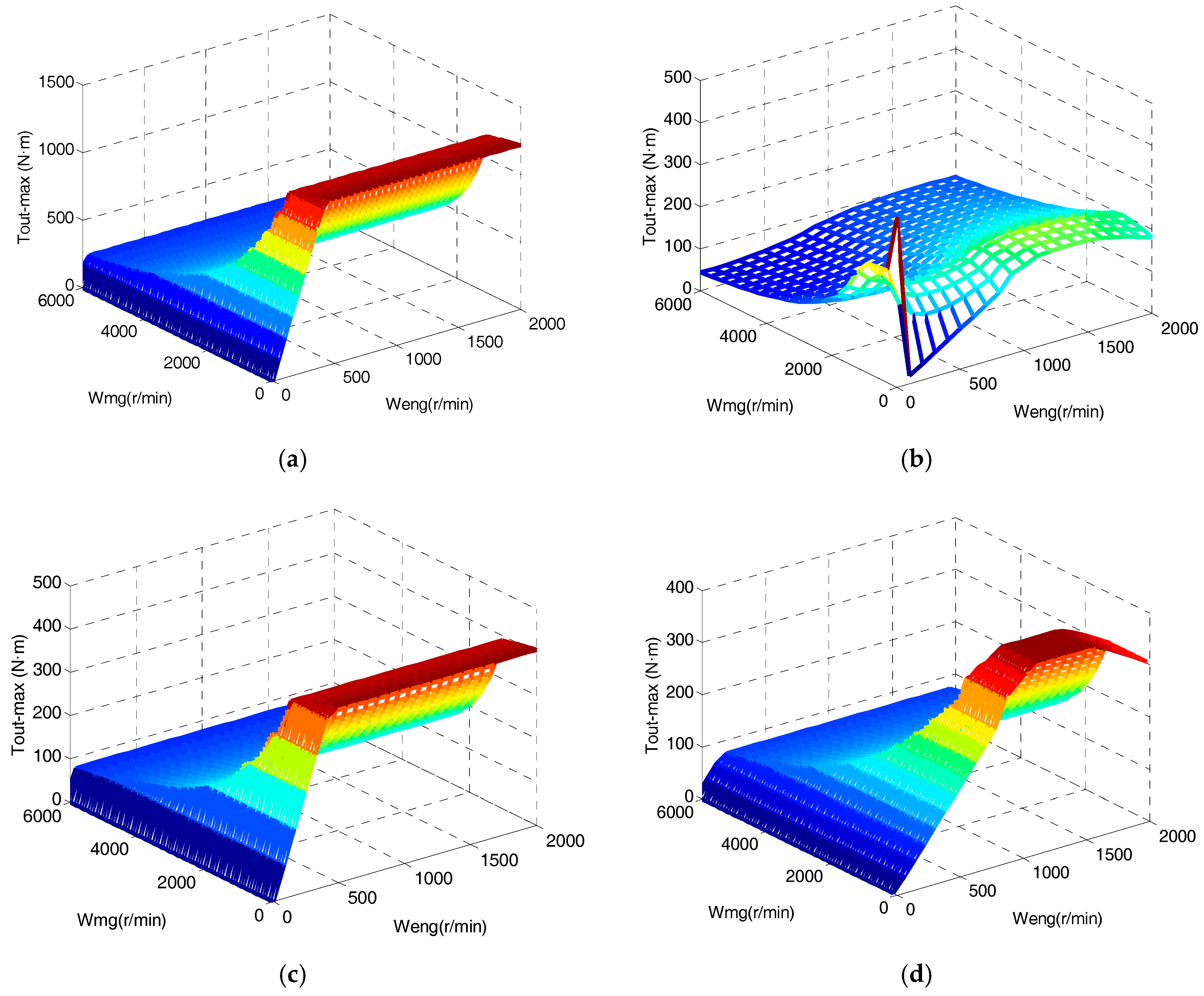

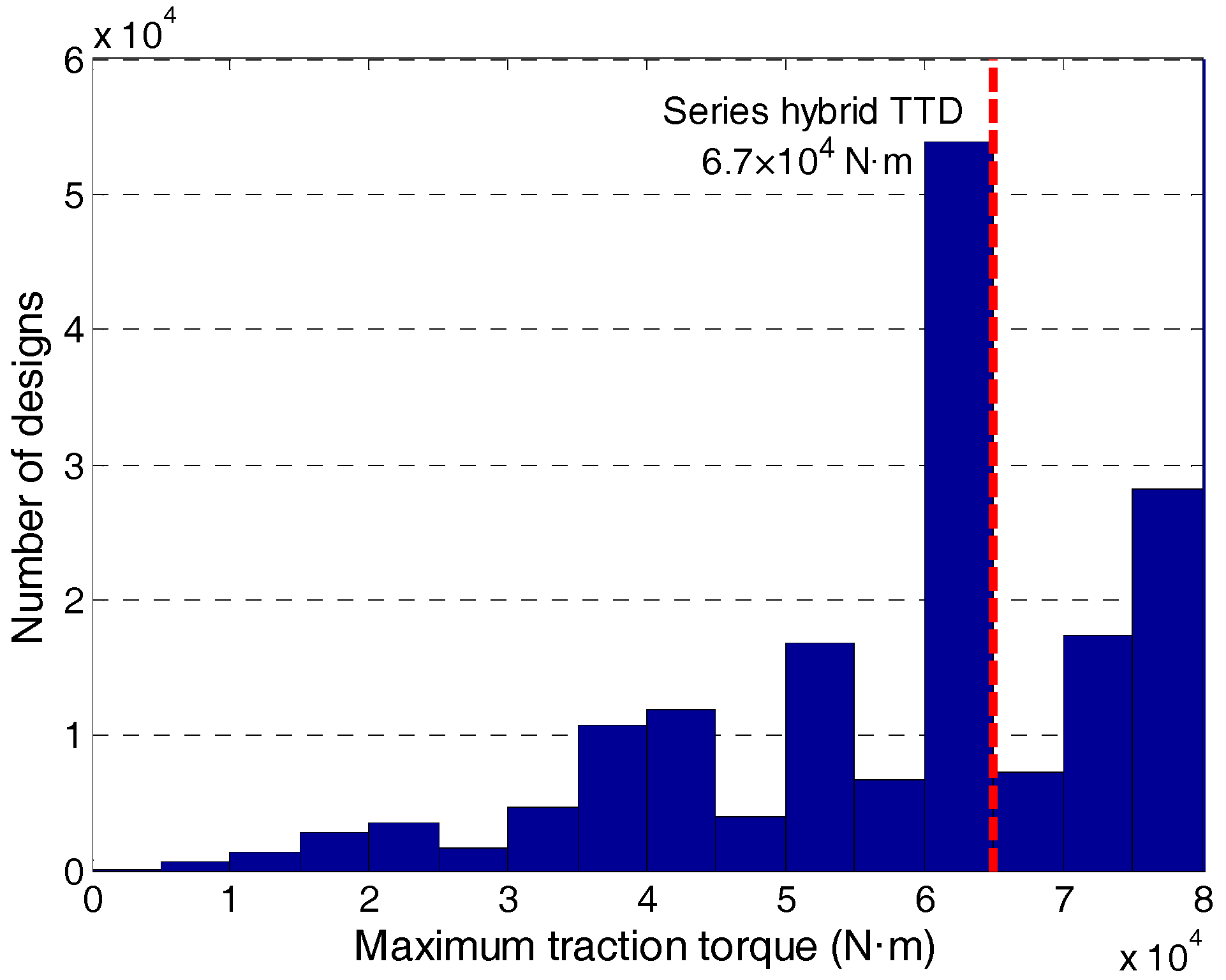
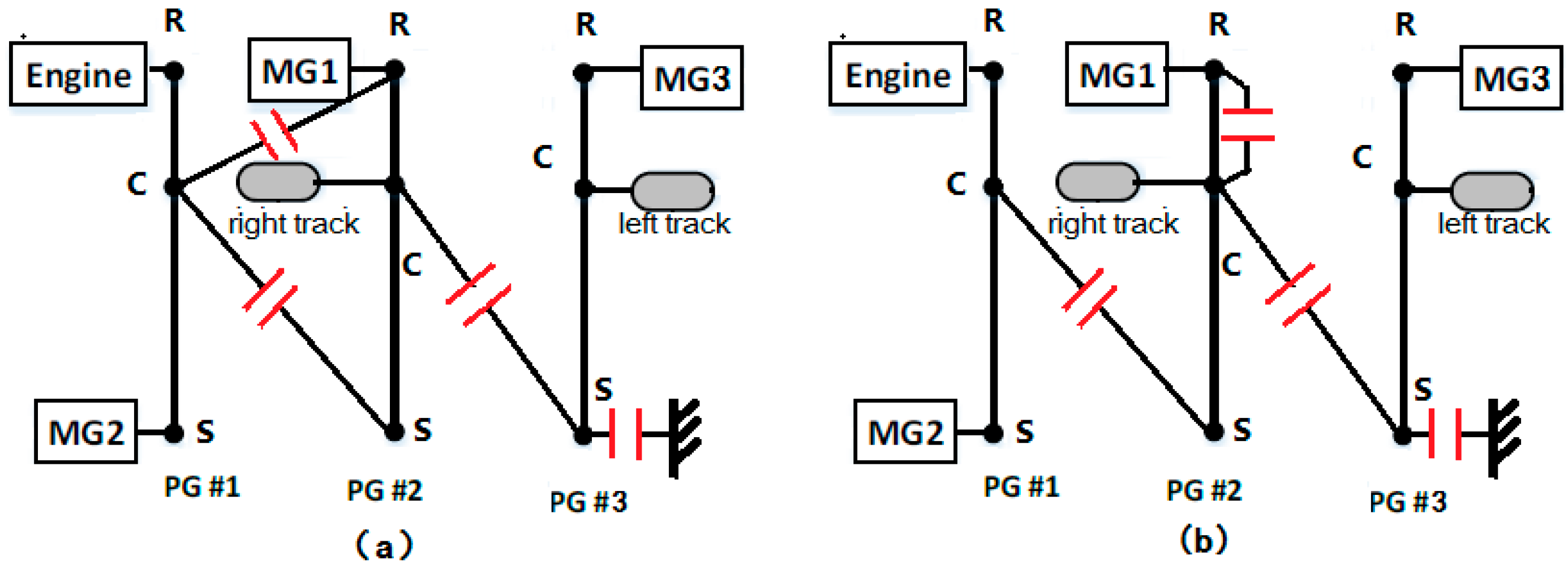
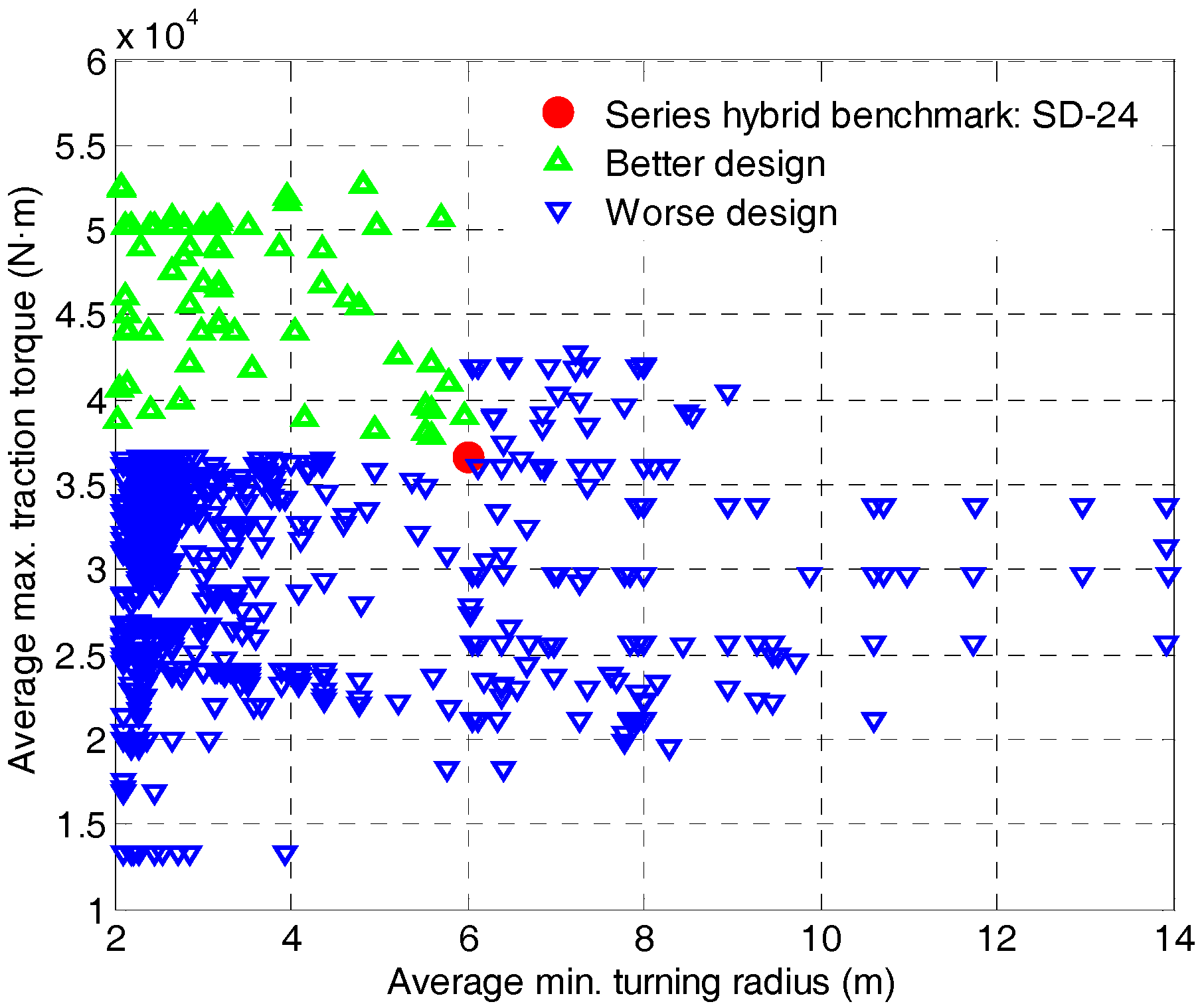
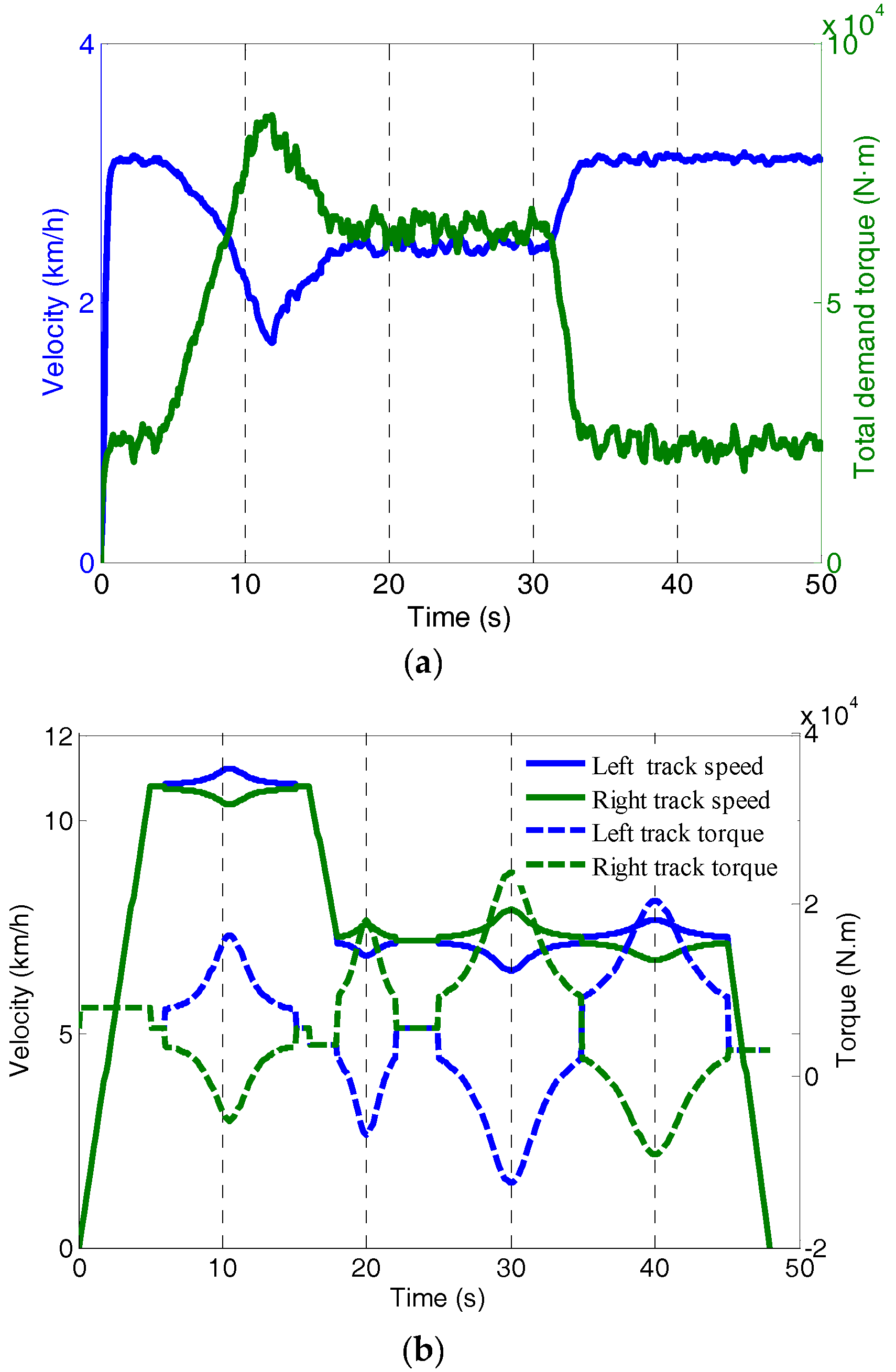

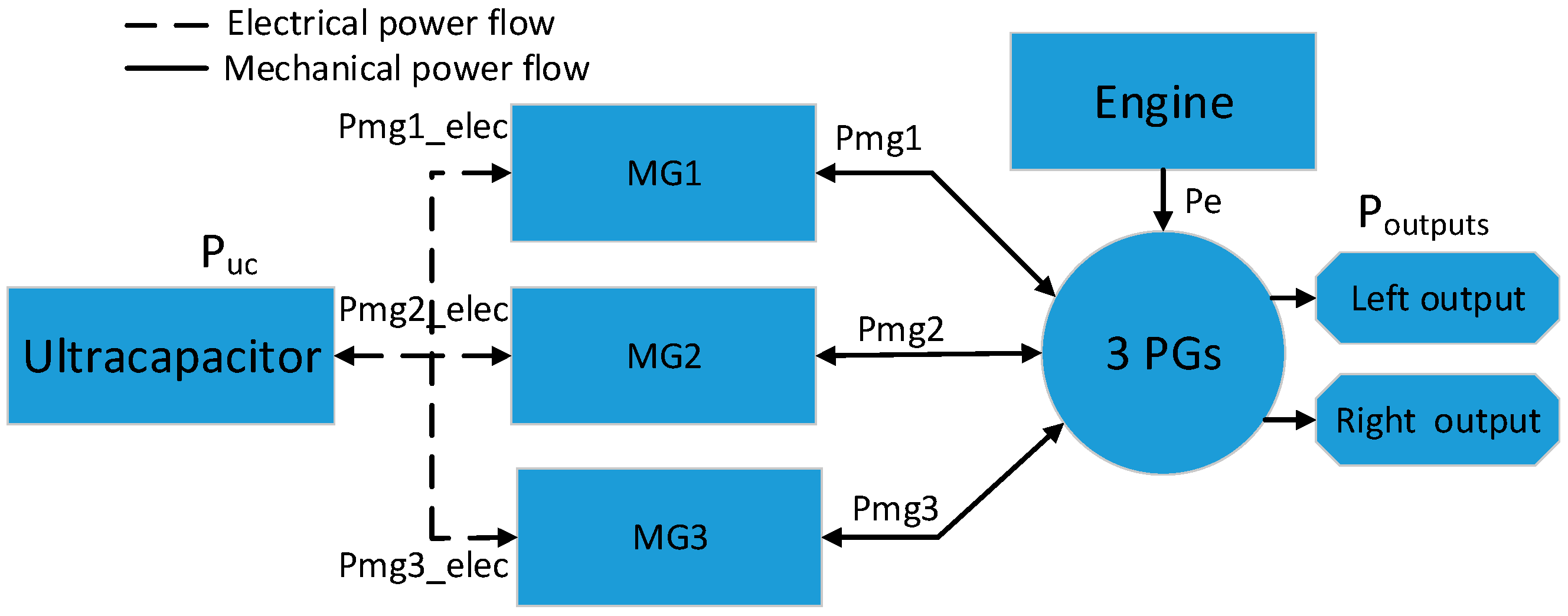
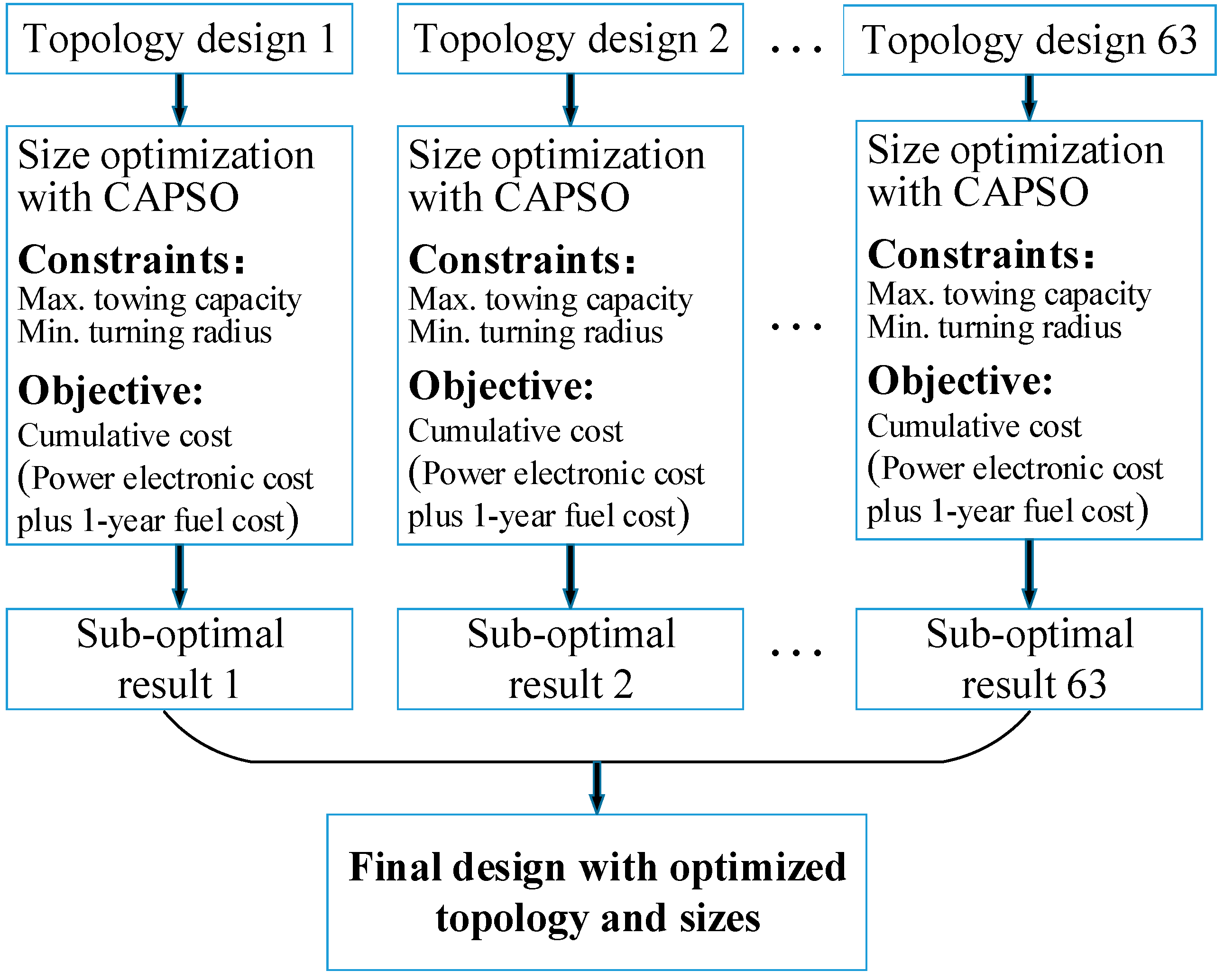


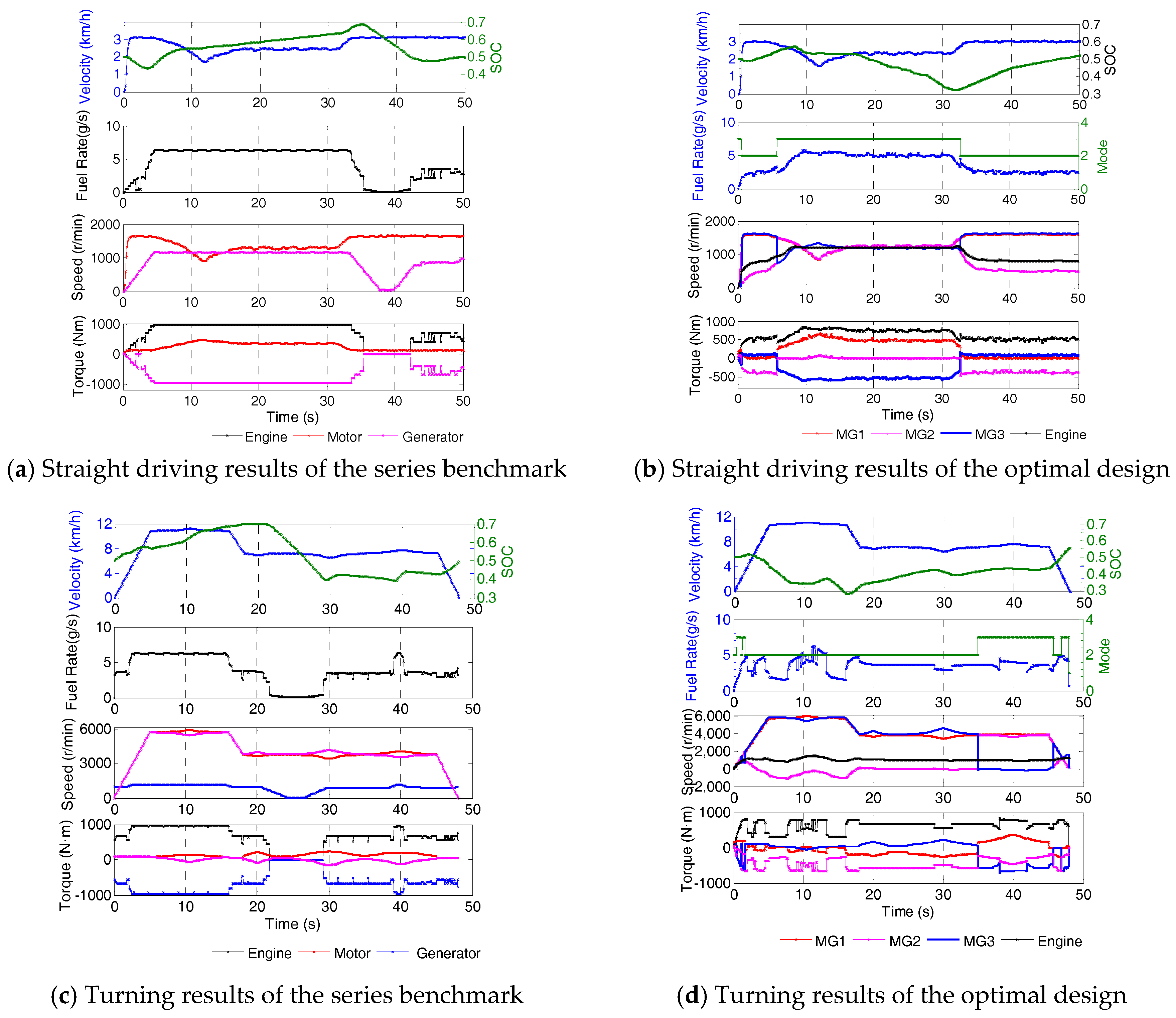

| Parameter | Value | |
|---|---|---|
| Vehicle | Vehicle mass (kg) | 28,000 |
| Track length (m) | 3.05 | |
| Track gauge (m) | 1.786 | |
| Diesel Engine | Rated speed (r/min) | 1700 |
| Rated power (kW) | 175 | |
| Generator | Max. power (kW) | 180 |
| Max. rotational speed (r/min) | 2200 | |
| Motors | Rated Power (kW) | 75 |
| Max. rotational speed (rpm) | 6000 | |
| Ultracapacitor | Capacity (F) | 2.4 |
| Voltage (V) | 600 |
| Type No. | Components Connected in One PG |
|---|---|
| 1 | Engine, Output, Motor |
| 2 | Engine, Motor, Motor |
| 3 | Motor, Motor, Output |
| 4 | Engine, Motor |
| 5 | Engine, Output |
| 6 | Motor, Output |
| 7 | Motor, Motor |
| Performance | Screening Conditions |
|---|---|
| Engine-on driving forwards | |
| Central Steering | |
| Engine-on driving backwards |
| States and Controls | Description |
|---|---|
| State 1 | State of charge (battery energy consumption) |
| State 2 | Current mode |
| Control 1 | Next mode |
© 2017 by the authors. Licensee MDPI, Basel, Switzerland. This article is an open access article distributed under the terms and conditions of the Creative Commons Attribution (CC BY) license (http://creativecommons.org/licenses/by/4.0/).
Share and Cite
Qin, Z.; Luo, Y.; Li, K.; Peng, H. Optimal Design of a Novel Hybrid Electric Powertrain for Tracked Vehicles. Energies 2017, 10, 2141. https://doi.org/10.3390/en10122141
Qin Z, Luo Y, Li K, Peng H. Optimal Design of a Novel Hybrid Electric Powertrain for Tracked Vehicles. Energies. 2017; 10(12):2141. https://doi.org/10.3390/en10122141
Chicago/Turabian StyleQin, Zhaobo, Yugong Luo, Keqiang Li, and Huei Peng. 2017. "Optimal Design of a Novel Hybrid Electric Powertrain for Tracked Vehicles" Energies 10, no. 12: 2141. https://doi.org/10.3390/en10122141




